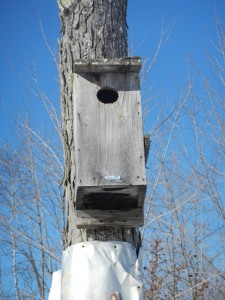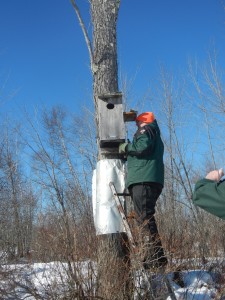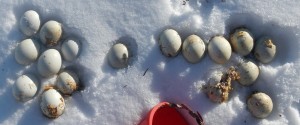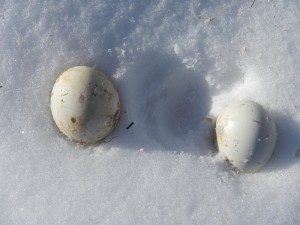February 3, 2014 at 1:37 pm
[caption id="attachment_357" align="alignleft" width="225"] One of the duck boxes on the Gregg Sanborn (Brownfield) WMA[/caption]
Wildlife biologists are taking advantage of the thick ice and cooler temperatures this time of year to investigate activity that may have occurred this past spring in duck boxes across the state.
Duck boxes are made most often from wood, but sometimes from metal or plastic; they are placed in wetland areas such as bogs or on streams to provide a nesting place for waterfowl in areas where natural snags and dead trees necessary for nesting are absent. In areas where the water level is stable, the boxes may be put up on tall posts in the water. In areas with dramatic water fluctuation, the boxes are more often put higher up on trees on the edge of the water. These boxes provide ideal nesting habitat for waterfowl that are cavity nesters: birds that seek to nest in dead tree snags with large holes rotted out of them. Some well-known cavity nesters are wood ducks, hooded mergansers, and goldeneyes.
The duck boxes are numbered so the use of each box can be monitored from year to year. The boxes are placed 5-10 feet off the ground. They are entirely enclosed except for a small hole in the front through which the female duck can enter and exit. Metal sheeting is wrapped around the tree or the pole (whichever is used to support the box) below the box to prevent predators like raccoons, squirrels, and snakes from climbing up to the box. Tall brush and small trees are often cleared away from the box to prevent squirrels from easily gaining access to the box by jumping from a neighboring tree or shrub to the box. The bottom of the box is filled with about four inches of pine shavings to supply a soft, insulating layer in which the female duck will lay her eggs.
[caption id="attachment_358" align="alignleft" width="225"]
One of the duck boxes on the Gregg Sanborn (Brownfield) WMA[/caption]
Wildlife biologists are taking advantage of the thick ice and cooler temperatures this time of year to investigate activity that may have occurred this past spring in duck boxes across the state.
Duck boxes are made most often from wood, but sometimes from metal or plastic; they are placed in wetland areas such as bogs or on streams to provide a nesting place for waterfowl in areas where natural snags and dead trees necessary for nesting are absent. In areas where the water level is stable, the boxes may be put up on tall posts in the water. In areas with dramatic water fluctuation, the boxes are more often put higher up on trees on the edge of the water. These boxes provide ideal nesting habitat for waterfowl that are cavity nesters: birds that seek to nest in dead tree snags with large holes rotted out of them. Some well-known cavity nesters are wood ducks, hooded mergansers, and goldeneyes.
The duck boxes are numbered so the use of each box can be monitored from year to year. The boxes are placed 5-10 feet off the ground. They are entirely enclosed except for a small hole in the front through which the female duck can enter and exit. Metal sheeting is wrapped around the tree or the pole (whichever is used to support the box) below the box to prevent predators like raccoons, squirrels, and snakes from climbing up to the box. Tall brush and small trees are often cleared away from the box to prevent squirrels from easily gaining access to the box by jumping from a neighboring tree or shrub to the box. The bottom of the box is filled with about four inches of pine shavings to supply a soft, insulating layer in which the female duck will lay her eggs.
[caption id="attachment_358" align="alignleft" width="225"] A MDIFW wildlife biologist cleans last year's nesting materials from one of the MDIFW maintained duck boxes on the Brownfield WMA. New nesting material will be added to prepare the box for use by a hen wood duck in the spring.[/caption]
Each winter, wildlife biologists head out to bogs and streams to check and refresh the nest boxes. The box number is recorded along with the contents of the box and how many species used the box. Some cavity-nesting species are parasitic nesters. This means that they will dump their eggs in a box occupied by another species for that other species to incubate and raise their young. When this happens, often that box is abandoned. The failed eggs are identified by species, counted, and removed from the box. The number of eggs hatched (indicated by the presence of egg shells and the soft membrane found on the inside surface of the hard shell) is also recorded. Old shavings and any other refuse such as rodent droppings, leaves, and moss that may have been dragged into the box are removed and fresh shavings are installed. This box cleaning helps reduce diseases that may be spread to the duck or her eggs if the boxes were left with dirty shavings.
In the spring, when the ducks are incubating their eggs, the wildlife biologists will trade the snowmobiles from this winter for canoes and head out to catch the hens in the boxes. They will band them and check for overall health and return them to their boxes. When the eggs have hatched and the ducklings have left the box to follow their mothers, the biologists will return to the wetlands and conduct ‘brood surveys’. These surveys, conducted multiple times in a season, give biologists an idea of how many young are successfully hatching and how many are surviving to a certain age.
While the boxes aid in increasing duck reproduction success, the banding and brood surveys are an important step in determining population growth and the dynamics of Maine’s duck species. Most of the duck boxes MDIFW monitors and maintains are located on our Wildlife Management Areas. The duck box program is yet another example of the time and effort
[caption id="attachment_359" align="alignright" width="300"]
A MDIFW wildlife biologist cleans last year's nesting materials from one of the MDIFW maintained duck boxes on the Brownfield WMA. New nesting material will be added to prepare the box for use by a hen wood duck in the spring.[/caption]
Each winter, wildlife biologists head out to bogs and streams to check and refresh the nest boxes. The box number is recorded along with the contents of the box and how many species used the box. Some cavity-nesting species are parasitic nesters. This means that they will dump their eggs in a box occupied by another species for that other species to incubate and raise their young. When this happens, often that box is abandoned. The failed eggs are identified by species, counted, and removed from the box. The number of eggs hatched (indicated by the presence of egg shells and the soft membrane found on the inside surface of the hard shell) is also recorded. Old shavings and any other refuse such as rodent droppings, leaves, and moss that may have been dragged into the box are removed and fresh shavings are installed. This box cleaning helps reduce diseases that may be spread to the duck or her eggs if the boxes were left with dirty shavings.
In the spring, when the ducks are incubating their eggs, the wildlife biologists will trade the snowmobiles from this winter for canoes and head out to catch the hens in the boxes. They will band them and check for overall health and return them to their boxes. When the eggs have hatched and the ducklings have left the box to follow their mothers, the biologists will return to the wetlands and conduct ‘brood surveys’. These surveys, conducted multiple times in a season, give biologists an idea of how many young are successfully hatching and how many are surviving to a certain age.
While the boxes aid in increasing duck reproduction success, the banding and brood surveys are an important step in determining population growth and the dynamics of Maine’s duck species. Most of the duck boxes MDIFW monitors and maintains are located on our Wildlife Management Areas. The duck box program is yet another example of the time and effort
[caption id="attachment_359" align="alignright" width="300"] All of these eggs were nestled in one box. The eggs are divided according to species. The 8 on the left are hooded merganser eggs. The 9 on the right are wood duck eggs. Both of these species are capable of 'dump nesting', or parasitic nesting. This is when a hen of a given species will 'dump' her eggs in a box being used by another hen of the same or a different species in an attempt to trick the other hen into raising her young. Usually 'dump nests' are abandoned by both hens.[/caption]
Maine’s wildlife biologists are putting into improving wildlife habitat on these public enjoyed lands.
[caption id="attachment_356" align="alignnone" width="300"]
All of these eggs were nestled in one box. The eggs are divided according to species. The 8 on the left are hooded merganser eggs. The 9 on the right are wood duck eggs. Both of these species are capable of 'dump nesting', or parasitic nesting. This is when a hen of a given species will 'dump' her eggs in a box being used by another hen of the same or a different species in an attempt to trick the other hen into raising her young. Usually 'dump nests' are abandoned by both hens.[/caption]
Maine’s wildlife biologists are putting into improving wildlife habitat on these public enjoyed lands.
[caption id="attachment_356" align="alignnone" width="300"] Both of these eggs were found in the same nest box. The egg on the left belongs to a wood duck. Usually the wood duck egg is off-white and slightly smaller than the white egg from the hooded merganser, on the right.[/caption]
Both of these eggs were found in the same nest box. The egg on the left belongs to a wood duck. Usually the wood duck egg is off-white and slightly smaller than the white egg from the hooded merganser, on the right.[/caption]
 One of the duck boxes on the Gregg Sanborn (Brownfield) WMA[/caption]
Wildlife biologists are taking advantage of the thick ice and cooler temperatures this time of year to investigate activity that may have occurred this past spring in duck boxes across the state.
Duck boxes are made most often from wood, but sometimes from metal or plastic; they are placed in wetland areas such as bogs or on streams to provide a nesting place for waterfowl in areas where natural snags and dead trees necessary for nesting are absent. In areas where the water level is stable, the boxes may be put up on tall posts in the water. In areas with dramatic water fluctuation, the boxes are more often put higher up on trees on the edge of the water. These boxes provide ideal nesting habitat for waterfowl that are cavity nesters: birds that seek to nest in dead tree snags with large holes rotted out of them. Some well-known cavity nesters are wood ducks, hooded mergansers, and goldeneyes.
The duck boxes are numbered so the use of each box can be monitored from year to year. The boxes are placed 5-10 feet off the ground. They are entirely enclosed except for a small hole in the front through which the female duck can enter and exit. Metal sheeting is wrapped around the tree or the pole (whichever is used to support the box) below the box to prevent predators like raccoons, squirrels, and snakes from climbing up to the box. Tall brush and small trees are often cleared away from the box to prevent squirrels from easily gaining access to the box by jumping from a neighboring tree or shrub to the box. The bottom of the box is filled with about four inches of pine shavings to supply a soft, insulating layer in which the female duck will lay her eggs.
[caption id="attachment_358" align="alignleft" width="225"]
One of the duck boxes on the Gregg Sanborn (Brownfield) WMA[/caption]
Wildlife biologists are taking advantage of the thick ice and cooler temperatures this time of year to investigate activity that may have occurred this past spring in duck boxes across the state.
Duck boxes are made most often from wood, but sometimes from metal or plastic; they are placed in wetland areas such as bogs or on streams to provide a nesting place for waterfowl in areas where natural snags and dead trees necessary for nesting are absent. In areas where the water level is stable, the boxes may be put up on tall posts in the water. In areas with dramatic water fluctuation, the boxes are more often put higher up on trees on the edge of the water. These boxes provide ideal nesting habitat for waterfowl that are cavity nesters: birds that seek to nest in dead tree snags with large holes rotted out of them. Some well-known cavity nesters are wood ducks, hooded mergansers, and goldeneyes.
The duck boxes are numbered so the use of each box can be monitored from year to year. The boxes are placed 5-10 feet off the ground. They are entirely enclosed except for a small hole in the front through which the female duck can enter and exit. Metal sheeting is wrapped around the tree or the pole (whichever is used to support the box) below the box to prevent predators like raccoons, squirrels, and snakes from climbing up to the box. Tall brush and small trees are often cleared away from the box to prevent squirrels from easily gaining access to the box by jumping from a neighboring tree or shrub to the box. The bottom of the box is filled with about four inches of pine shavings to supply a soft, insulating layer in which the female duck will lay her eggs.
[caption id="attachment_358" align="alignleft" width="225"] A MDIFW wildlife biologist cleans last year's nesting materials from one of the MDIFW maintained duck boxes on the Brownfield WMA. New nesting material will be added to prepare the box for use by a hen wood duck in the spring.[/caption]
Each winter, wildlife biologists head out to bogs and streams to check and refresh the nest boxes. The box number is recorded along with the contents of the box and how many species used the box. Some cavity-nesting species are parasitic nesters. This means that they will dump their eggs in a box occupied by another species for that other species to incubate and raise their young. When this happens, often that box is abandoned. The failed eggs are identified by species, counted, and removed from the box. The number of eggs hatched (indicated by the presence of egg shells and the soft membrane found on the inside surface of the hard shell) is also recorded. Old shavings and any other refuse such as rodent droppings, leaves, and moss that may have been dragged into the box are removed and fresh shavings are installed. This box cleaning helps reduce diseases that may be spread to the duck or her eggs if the boxes were left with dirty shavings.
In the spring, when the ducks are incubating their eggs, the wildlife biologists will trade the snowmobiles from this winter for canoes and head out to catch the hens in the boxes. They will band them and check for overall health and return them to their boxes. When the eggs have hatched and the ducklings have left the box to follow their mothers, the biologists will return to the wetlands and conduct ‘brood surveys’. These surveys, conducted multiple times in a season, give biologists an idea of how many young are successfully hatching and how many are surviving to a certain age.
While the boxes aid in increasing duck reproduction success, the banding and brood surveys are an important step in determining population growth and the dynamics of Maine’s duck species. Most of the duck boxes MDIFW monitors and maintains are located on our Wildlife Management Areas. The duck box program is yet another example of the time and effort
[caption id="attachment_359" align="alignright" width="300"]
A MDIFW wildlife biologist cleans last year's nesting materials from one of the MDIFW maintained duck boxes on the Brownfield WMA. New nesting material will be added to prepare the box for use by a hen wood duck in the spring.[/caption]
Each winter, wildlife biologists head out to bogs and streams to check and refresh the nest boxes. The box number is recorded along with the contents of the box and how many species used the box. Some cavity-nesting species are parasitic nesters. This means that they will dump their eggs in a box occupied by another species for that other species to incubate and raise their young. When this happens, often that box is abandoned. The failed eggs are identified by species, counted, and removed from the box. The number of eggs hatched (indicated by the presence of egg shells and the soft membrane found on the inside surface of the hard shell) is also recorded. Old shavings and any other refuse such as rodent droppings, leaves, and moss that may have been dragged into the box are removed and fresh shavings are installed. This box cleaning helps reduce diseases that may be spread to the duck or her eggs if the boxes were left with dirty shavings.
In the spring, when the ducks are incubating their eggs, the wildlife biologists will trade the snowmobiles from this winter for canoes and head out to catch the hens in the boxes. They will band them and check for overall health and return them to their boxes. When the eggs have hatched and the ducklings have left the box to follow their mothers, the biologists will return to the wetlands and conduct ‘brood surveys’. These surveys, conducted multiple times in a season, give biologists an idea of how many young are successfully hatching and how many are surviving to a certain age.
While the boxes aid in increasing duck reproduction success, the banding and brood surveys are an important step in determining population growth and the dynamics of Maine’s duck species. Most of the duck boxes MDIFW monitors and maintains are located on our Wildlife Management Areas. The duck box program is yet another example of the time and effort
[caption id="attachment_359" align="alignright" width="300"] All of these eggs were nestled in one box. The eggs are divided according to species. The 8 on the left are hooded merganser eggs. The 9 on the right are wood duck eggs. Both of these species are capable of 'dump nesting', or parasitic nesting. This is when a hen of a given species will 'dump' her eggs in a box being used by another hen of the same or a different species in an attempt to trick the other hen into raising her young. Usually 'dump nests' are abandoned by both hens.[/caption]
Maine’s wildlife biologists are putting into improving wildlife habitat on these public enjoyed lands.
[caption id="attachment_356" align="alignnone" width="300"]
All of these eggs were nestled in one box. The eggs are divided according to species. The 8 on the left are hooded merganser eggs. The 9 on the right are wood duck eggs. Both of these species are capable of 'dump nesting', or parasitic nesting. This is when a hen of a given species will 'dump' her eggs in a box being used by another hen of the same or a different species in an attempt to trick the other hen into raising her young. Usually 'dump nests' are abandoned by both hens.[/caption]
Maine’s wildlife biologists are putting into improving wildlife habitat on these public enjoyed lands.
[caption id="attachment_356" align="alignnone" width="300"] Both of these eggs were found in the same nest box. The egg on the left belongs to a wood duck. Usually the wood duck egg is off-white and slightly smaller than the white egg from the hooded merganser, on the right.[/caption]
Both of these eggs were found in the same nest box. The egg on the left belongs to a wood duck. Usually the wood duck egg is off-white and slightly smaller than the white egg from the hooded merganser, on the right.[/caption]Categories